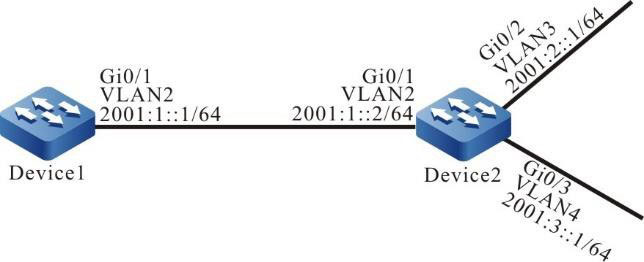Network Requirements
- Run RIPng between Device1 and Device2 for route interaction.
- Device1 has learnt the two routes 2001:2::/64 and 2001:3::/64 advertised by Device2, and then, the route 2001:3::/64 is filtered in the advertising direction of Device2.
Network Topology

Figure 6-4 Networking for configuring RIPng Route filtration
Configuration Steps
Step 1: Create VLANs, and add ports to the required VLANs. (Omitted)
Step 2: Configure the IPv6 address of an interface (omitted).
Step 3: Configure RIPng.
#Configure Device1.
|
Device1#configure terminal
Device1(config)#ipv6 router rip 100
Device1(config-ripng)#exit
Device1(config)#interface vlan2
Device1(config-if-vlan2)#ipv6 rip enable 100
Device1(config-if-vlan2)#exit
|
#Configure Device2.
|
Device2#configure terminal
Device2(config)#ipv6 router rip 100
Device2(config-ripng)#exit
Device2(config)#interface vlan2
Device2(config-if-vlan2)#ipv6 rip enable 100
Device2(config-if-vlan2)#exit
Device2(config)#interface vlan3
Device2(config-if-vlan3)#ipv6 rip enable 100
Device2(config-if-vlan3)#exit
Device2(config)#interface vlan4
Device2(config-if-vlan4)#ipv6 rip enable 100
Device2(config-if-vlan4)#exit
|
#View the IPv6 route table of Device1.
Device1#show ipv6 route
Codes: C - Connected, L - Local, S - static, R - RIP, B - BGP, i-ISIS
U - Per-user Static route
O - OSPF, OE-OSPF External, M - Management
L ::1/128 [0/0]
via ::, 2w5d:02:47:44, lo0
C 2001:1::/64 [0/0]
via ::, 00:56:34, vlan2
L 2001:1::1/128 [0/0]
via ::, 00:56:32, lo0
R 2001:2::/64 [120/2]
via fe80::201:7aff:fec3:38a4, 00:27:11, vlan2
R 2001:3::/64 [120/2]
via fe80::201:7aff:fec3:38a4, 00:27:11, vlan2
You can see that Device1 has learnt the two routes advertised by Device2.
Step 4: Configure the IPv6 prefix list.
|
Device2(config)#ipv6 prefix-list RIPng deny 2001:3::/64
|
Step 5: Configure the route filtration.
#Configure route filtering in the output direction of interface vlan2 of Device2.
|
Device2(config)#ipv6 router rip 100
Device2(config-ripng)#distribute-list prefix RIPng out vlan2
Device2(config-ripng)#exit
|
Step 6: Check the result.
#View the IPv6 route table of Device1.
Device1#show ipv6 route
Codes: C - Connected, L - Local, S - static, R - RIP, B - BGP, i-ISIS
U - Per-user Static route
O - OSPF, OE-OSPF External, M - Management
L ::1/128 [0/0]
via ::, 2w5d:03:03:49, lo0
C 2001:1::/64 [0/0]
via ::, 01:12:39, vlan2
L 2001:1::1/128 [0/0]
via ::, 01:12:38, lo0
R 2001:2::/64 [120/2]
via fe80::201:7aff:fec3:38a4, 00:43:16, vlan2
According to the routing table, Device2 does not advertise route 2001:3::/64 to Device1, but the route is deleted from the routing table of Device1 only after the route times out.

-
The distribute-list can be applied to all interfaces or a specified interface, and it can be used in the receiving or advertising direction.
 Switch
Switch Wifi - Access Point
Wifi - Access Point Firewall
Firewall Router
Router Module Quang
Module Quang![Module Quang Cisco]() Module Quang Cisco
Module Quang Cisco![Module quang HPE]() Module quang HPE
Module quang HPE![Module quang Maipu]() Module quang Maipu
Module quang Maipu![Module quang Brocade]() Module quang Brocade
Module quang Brocade![Module quang Fortinet]() Module quang Fortinet
Module quang Fortinet![Module quang Aruba]() Module quang Aruba
Module quang Aruba![Module quang OEM]() Module quang OEM
Module quang OEM![Module quang Juniper]() Module quang Juniper
Module quang Juniper![Module quang Dell]() Module quang Dell
Module quang Dell![Module quang Palo Alto]() Module quang Palo Alto
Module quang Palo Alto![Module quang Huawei]() Module quang Huawei
Module quang Huawei![Module quang Arista]() Module quang Arista
Module quang Arista![Module quang F5]() Module quang F5
Module quang F5![Module quang H3C]() Module quang H3C
Module quang H3C![Module Quang Allied Telesis]() Module Quang Allied Telesis
Module Quang Allied Telesis![Module quang SonicWall]() Module quang SonicWall
Module quang SonicWall![Module quang Mikrotik]() Module quang Mikrotik
Module quang Mikrotik![Module quang Handar]() Module quang Handar
Module quang Handar Máy chủ (Server)
Máy chủ (Server) Thiết bị lưu trữ (SAN, NAS)
Thiết bị lưu trữ (SAN, NAS) Load Balancing
Load Balancing Video Conferencing
Video Conferencing Phụ kiện máy chủ
Phụ kiện máy chủ Thiết Bị IoT
Thiết Bị IoT Phụ Kiện Mạng
Phụ Kiện Mạng




.png)
























